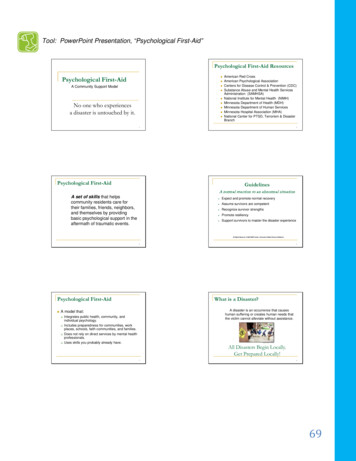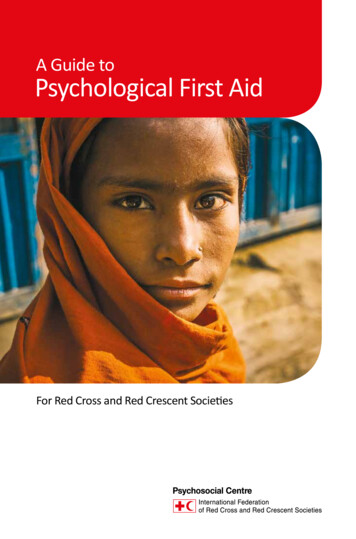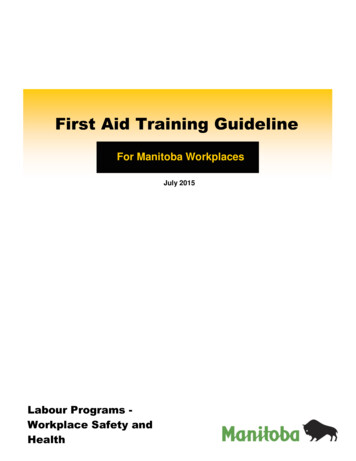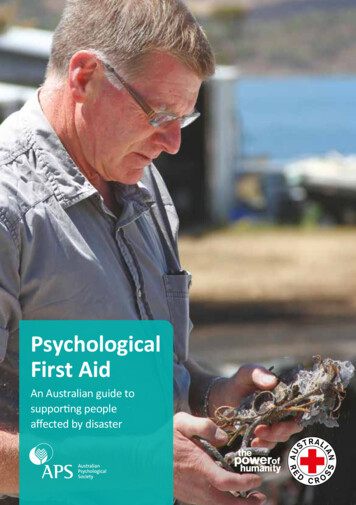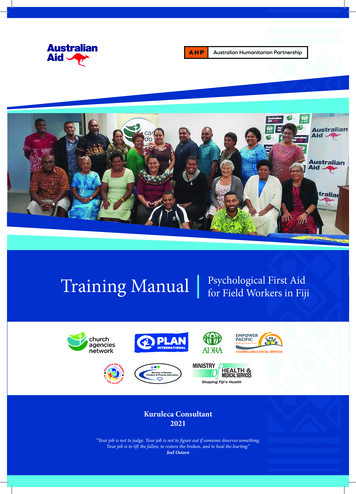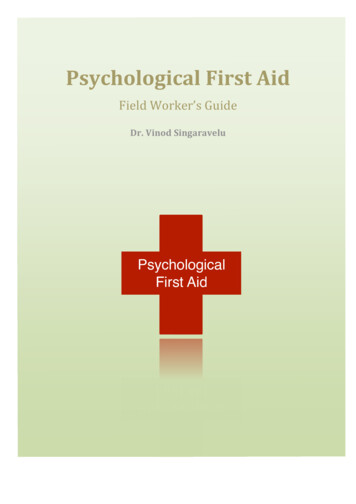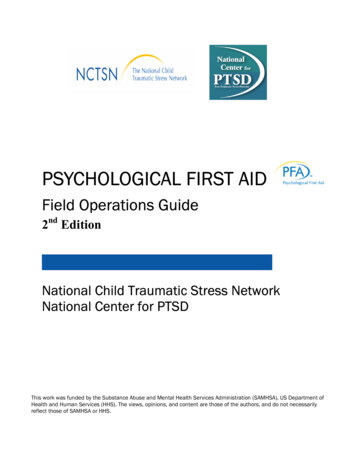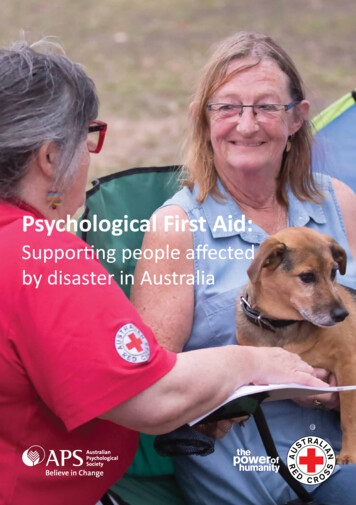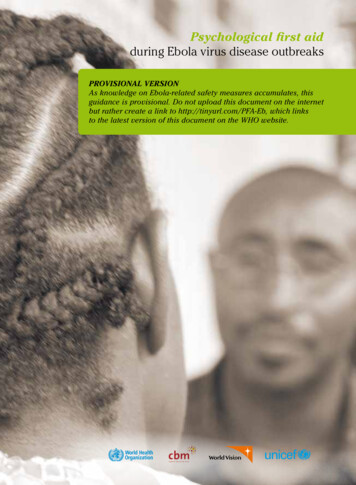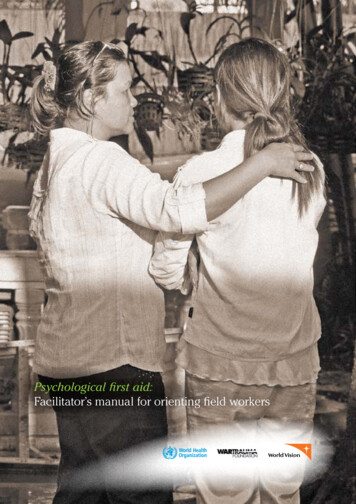
Transcription
Psychological first aid:Facilitator’s manual for orienting field workers
WHO Library Cataloguing-in-Publication DataPsychological first aid: Facilitator’s manual for orienting field workers.1.Crisis intervention – methods. 2.Disasters. 3.Emergency medical services – personnel.4.Adaptation, Psychological. 5.First aid – psychology. 6.Stress disorders, Traumatic – psychology.7.Health personnel – education. I.World Health Organization. II.War Trauma Foundation. III.WorldVision International.ISBN 978 92 4 154861 8(NLM classification: WM 401) World Health Organization 2013All rights reserved. Publications of the World Health Organization are available on the WHOweb site (www.who.int) or can be purchased from WHO Press, World Health Organization,20 Avenue Appia, 1211 Geneva 27, Switzerland (tel.: 41 22 791 3264; fax: 41 22 791 4857;email: bookorders@who.int).Requests for permission to reproduce or translate WHO publications –whether for sale or fornon‑commercial distribution– should be addressed to WHO Press through the WHO web site(www.who.int/about/licensing/copyright form/en/index.html).The mention of specific companies or of certain manufacturers’ products does not imply thatthey are endorsed or recommended by the World Health Organization in preference to others ofa similar nature that are not mentioned. Errors and omissions excepted, the names of proprietaryproducts are distinguished by initial capital letters.All reasonable precautions have been taken by the World Health Organization to verify theinformation contained in this publication. However, the published material is being distributedwithout warranty of any kind, either expressed or implied. The responsibility for the interpretationand use of the material lies with the reader. In no event shall the World Health Organization beliable for damages arising from its use.Suggested citation: World Health Organization, War Trauma Foundation and World VisionInternational (2013). Psychological first aid: Facilitator’s manual for orienting field workers.WHO: Geneva.For feedback or questions on technical aspects of this publication, please contact: Mark van Ommeren, Department of Mental Health and Substance Abuse, World HealthOrganization, 20 Avenue Appia, 1211 Geneva 27, Switzerland (email: vanommerenm@who.int); Leslie Snider, War Trauma Foundation, Nienoord 5, 1112 XE Diemen, the Netherlands(email: l.snider@wartrauma.nl); Alison Schafer, Mental Health and Psychosocial Support, Humanitarian and Emergency AffairsTeam, World Vision Australia. 1 Vision Drive, Burwood East, Victoria, 3151, Australia(email: alison.schafer@worldvision.com.au).
PFA FACILITATOR’SMANUALPsychological first aid:Facilitator’s manual for orienting field workers
ACKNOWLEDGEMENTSThis document was written by Leslie Snider (War Trauma Foundation) in close consultationwith Alison Schafer (World Vision International (WVI)), Mark van Ommeren (World HealthOrganization (WHO) Department of Mental Health and Substance Abuse) and Khalid Saeed(WHO Regional Office for the Eastern Mediterranean).We thank the following reviewers: Megan McGrath (WVI), Devora Kestel (WHO/Pan AmericanHealth Organization), Sarah Harrison (United Nations Health Commissioner for Refugees), InkaWeissbecker (International Medical Corps) and Emmanuel Streel (consultant).The work was funded by the WHO Regional Office for the Eastern Mediterranean andWorld Vision Australia.Psychological first aid: Guide for field workersiiPsychological first aid: Facilitator’s manual for orienting field workers
IIOVERVIEW OF THE MANUAL1Introduction2How to Use this Manual2Preparing to Deliver the Orientation3!Facilitation TipsCONTENTSACKNOWLEDGEMENTS5STEP-BY-STEP ORIENTATIONAgenda for a 4-hour orientation910Orientation ModulesPART I:PFA definition and framework11PART II: Applying PFA action principles30PART III: PFA role plays and wrap-up, self and team care, evaluation47SUPPORTING MATERIALS60Annex 1: PFA Pocket Guide61Annex 2: Optional Pre/Post Test (for full-day orientations)63Annex 3: Simulation Instructions66Annex 4: Case Scenario Instructions67Annex 5: Communication Exercise Instructions70Annex 6: Good Communication Handout73Annex 7: Things Caregivers Can Do to Help Children Handout74Annex 8: Vulnerable People Exercise Instructions75Annex 9: Evaluation Form78Annex 10: Brief Relaxation Exercise for Helper Self Care (for full-day orientations)79Annex 11: Full-Day Orientation Agenda80Psychological first aid: Facilitator’s manual for orienting field workersiii
OVERVIEW OFTHE MANUAL1Psychological first aid: Facilitator’s manual for orienting field workers
OVERVIEWINTRODUCTIONThis manual is designed to orient helpers to offer psychological first aid (PFA) to people followinga serious crisis event. PFA involves humane, supportive and practical assistance for people who aredistressed, in ways that respect their dignity, culture and abilities.This facilitator’s manual is to be used together with the Psychological first aid: Guide for field workers(World Health Organization, War Trauma Foundation, World Vision International, 2011).The manual is structured in three parts:1) Overview of the manualThis section provides general information about how to use this manual, how to prepare for giving anorientation, and tips for facilitators.2) Step-by-step orientationThis section provides a half-day orientation agenda and a step-by-step description of each module,including learning objectives, narrative and tips for the facilitator, accompanying slides, andinstructions for group exercises and discussion.3) Supporting materialsThis section of annexes provides supporting materials to print as handouts for participants.HOW TO USE THIS MANUALThe instructions and materials in this manual are for a half-day orientation (four hours excludingbreaks) to prepare helpers to support people recently affected by very stressful events. If you havemore time available for the orientation, the extra activities and slides included in the text boxes can beused to deliver a full-day orientation (five-and-a-half hours excluding breaks). Where possible, full-dayorientations should be organized to allow for deeper learning.It is important to adapt the orientation and materials to the local culture, language and context,and to the likely kinds of crisis situation in which your participants will be helping. Rememberto build in extra time if you are using a translator. It is helpful if the translator is familiar withPsychological first aid: Guide for field workers and orientation materials beforehand.This manual serves as a guide for PFA orientation, to which you can bring your own style, experienceand ideas as a facilitator.What will participants learn?The orientation aims to build the capacity of helpers in crisis situations:»» To approach a situation safely, for themselves and others;»» To say and do the most supportive things for very distressed people; and»» To NOT cause further harm by their actions.Psychological first aid: Facilitator’s manual for orienting field workers2
The orientation provides many opportunities for participants to develop and practise PFA skills.The orientation will not give participants clinical skills in “counselling.” A key learning objective is forparticipants to understand the boundaries of the support they can provide and when to refer people formore specialized assistance.Who is this manual for?Facilitators using this manual will often have experience in offering mental health and psychosocialsupport. It is helpful if they also have:»» Prior experience assisting people affected by crisis events»» Interest and experience in providing orientation and training.Who should participate in a PFA orientation?PFA is an approach that can be learned by both professionals and non-professionals who are in aposition to help people impacted by very distressing events. They may include staff or volunteers ofdisaster relief organizations (in health and non-health sectors), health workers, teachers, communitymembers, local government officials and others.It is not necessary for helpers to have a psychosocial or mental health background in order to be ableto offer PFA. Helpers who provide various kinds of relief and assistance during a crisis event may findPFA skills useful in the course of their usual work. Participants will ideally:»» Have the time and willingness to assist in crisis situations.»» Be accessible and available to help people in distress.»» Be connected with a recognized agency or group if assisting in a large emergency (for theirsafety and for the coordination of effective response).PREPARING TO DELIVER THE ORIENTATIONEven if you are working in an acute crisis situation, you should take time to prepare for the orientationso that it will run smoothly and be a useful experience for your participants. The following checklistswill help you to prepare for the orientation, including:FF Preparing yourself: what you need to knowFF Preparing materials and handoutsFF Preparing the venue.Preparing yourself: what you need to knowAs you prepare to offer the orientation, first become familiar with:FFFFFFFF13The publication Psychological first aid: Guide for field workersThis manual, including handouts, slides1 and activitiesBackground of participants (culture, language, profession, helping role)The kinds of crisis event in which participants would be helping.The slides are available at: http://www.who.int/mental health/resources/emergencies/en/Psychological first aid: Facilitator’s manual for orienting field workers
The following key document is also useful to review and is freely available in several languages:Inter‑Agency Standing Committee (IASC, 2007) Guidelines on mental health and psychosocial support inemergencies: Checklist for field use.4Preparing materials and handoutsGive all participants a printed copy of the two-page PFA pocket guide (see Annex 1) in their locallanguage. If possible, also provide handouts, other materials and Psychological first aid: Guide forfield workers in the local language. Note: The PFA pocket guide and handouts can also be found inthe Psychological first aid: Guide for field workers. Check whether the guide already exists in the locallanguage by consulting the previously mentioned WHO website.Tailor the orientation materials to the cultural and social context of participants. For example, adapt orcreate new case scenarios depending upon the local context and types of crisis situation participantsmay encounter.Also adapt the orientation agenda to your specific orientation; i.e. mention specific start and end times.Use the following checklist to ensure you have all printed materials ready for your orientation(see Annexes):FFFFFFFFFFFFFFFFPFA pocket guide in the local languagePsychological first aid: Guide for field workers (electronic or printed copy)The workshop agendaPre- and post-test (optional)Case scenario and simulation instructionsCommunication exercise instructionsVulnerable people exercise instructionsHandouts (these can also be found in the Psychological first aid: Guide for field workers):»» Good communication»» How caregivers can help their childrenFF Written evaluation form2See http://www.who.int/mental health/publications/guide field workers/en/index.html3See http://apps.who.int./bookorders/4See age content-products-products&productcatid 22Psychological first aid: Facilitator’s manual for orienting field workers4OVERVIEWThe publication Psychological first aid: Guide for field workers is freely available in numerous languageselectronically in PDF format,2 and hard copies can be ordered from the WHO bookstore.3
Preparing the venueWhere you hold the orientation depends in part upon the situation. If you are working in an acute crisissituation, proper meeting rooms and facilities may not be readily available. Alternative meeting spacessuch as a tent or even outdoor areas can be used instead. Use the following checklist to be sure thevenue is adequate and ready to go:FFFFFFFFFFAdequate space for the number of participants attendingFFFFFFFFFFFlipchart or whiteboard, and markersSufficient comfort and safety for participantsSufficient privacy and quiet. If relevant, check the venue’s sound system before the orientationTables and chairs that can be moved or flexibly arranged to allow for role play and group work aptop and LCD projector if electricity is available (otherwise, consider printing handouts ofLthe slides beforehand)Tape or tacks for hanging overhead paperPens and notebooks for participantsSign-in sheet and name tags (if used)Refreshments.! FACILITATION TIPSAs a facilitator, you can enhance the learning environment by:1. Modelling the skills2. Creating a safe and supportive atmosphere3. Utilizing participatory learning4. Managing time well.Modelling the skillsAs you facilitate the orientation, aim to model the skills and helping qualities you would likeparticipants to learn:»» Be friendly, warm, relaxed and calm to engage participants.»» Demonstrate good verbal and non-verbal communication skills, to convey interest andenthusiasm with your words and body language.»» Demonstrate positive regard, respect and non-judgement.If you are working with a co-facilitator, try to convey good team spirit and mutual support as a modelfor self and team care in the field.Creating a safe and supportive atmosphereOrientation to PFA involves discussing and role playing crisis events and distress. This can touch uponparticipants’ own experiences and their memories, feelings and reactions to past or current events.Some participants may also be directly impacted by the crisis in which they will be helping. As afacilitator, aim to set a safe and supportive atmosphere for the orientation:5Psychological first aid: Facilitator’s manual for orienting field workers
»» Set ground rules at the start of the orientation to maintain a productive and supportiveOVERVIEWatmosphere for everyone.»» When starting the orientation, acknowledge the potential for it to touch on distressing stories orpersonal experiences.»» Moderate or stop any discussions that seem too distressing for the group.»» If participants appear distressed or come to you with concerns, be available to assist them:»» Listen without judgement and help them to feel calm.»» Give options for how they can participate comfortably in the orientation activities.»» Provide referral for additional support as necessary and available.Utilizing participatory learningParticipatory learning methods, such as simulations, role plays and case scenarios, are powerfultools for helping adults to develop PFA skills. The more time participants have to practise theircommunication and helping skills, the more they will benefit from the orientation.As participants take on the roles of being a helper or a person in distress, they often feel the role theyare playing and directly experience the helpful and unhelpful things to say and do. Participants willhave the chance to try out their helping skills in a safe environment where they can receive feedbackand learn from each other. These methods also provide opportunities to discuss how to adapt PFA tothe local context.Some participants will be new to participatory learning methods and may feel shy in trying role plays.It may help to acknowledge that it takes courage to risk making mistakes in front of peers, and thateveryone will do things well – and not so well – as they practise PFA skills. Both are useful for learning.Tips to encourage participation:»»»»»»»»»»Begin with introductions so participants can meet each other.Learn and use participants’ names (name tags are helpful).Ask what participants expect of the orientation.Use energizers (games) to engage participants.Limit lecture time. Rather, engage participants in exchanging ideas and experiencethrough dialogue.»» Acknowledge participants’ existing knowledge and natural helping abilities.»» Be encouraging and positive as participants practise new skills.»» Always give feedback in a sensitive way: first ask “what went well” and then“what could be better.”»» Invite questions and allow time for clarification.»» Be open to feedback on how the orientation is going, and make adjustments as needed.Tips for group work:»» Be aware of very quiet or shy participants, or those who dominate discussions. Try to ensure thateveryone has the opportunity to actively participate.»» Ensure a manageable number of members for group work (4–6 participants) to allow for gooddialogue and participation by everyone.Psychological first aid: Facilitator’s manual for orienting field workers6
Tips for adapting to participants’ cultural and social contexts:»» Encourage participants to come up with case examples relevant to the context in which theywill be helping.»» Invite participants to discuss how to adapt PFA to their cultures.It is normal that both facilitators and participants will make mistakes when demonstrating PFA. To besure that participants understand what good PFA skills are and what should be avoided, clearly outlinethe main points or “take-home messages” at the end of all practice activities. Write the main points ona flipchart or show the slides, and refer to the two-page PFA pocket guide.Managing time wellTime management is an essential part of good facilitation. The agenda provided is a guide for timingthe orientation. However, it may sometimes be difficult to judge how long a role play or exercise maytake, or you may want to give extra time to a certain topic for purposes of clarification. Consider thesetips to help manage time effectively:»» Schedule arrival and registration time prior to the start of training.»» Start and end on time.»» Discuss the agenda with participants at the start of the orientation, and keep to the generalschedule (including the short break times).»» Do not spend too much time on the slides. Rather, be sure there is sufficient time for discussions,role plays and simulations, where much of the learning is likely to take place.»» Manage the duration of role plays so that they do not go on too long.»» If using a translator, be prepared for the orientation to take longer.»» Allow time for final questions, clarification and evaluation at the close of the orientation.7Psychological first aid: Facilitator’s manual for orienting field workers
Psychological first aid: Facilitator’s manual for orienting field workers8
STEP-BY-STEPORIENTATION9Psychological first aid: Facilitator’s manual for orienting field workers
AGENDA FOR A 4-HOUR ORIENTATION (EXCLUDING BREAKS)For the full-day agenda, please see Annex 11.OverviewDurationPre-orientationPart I (70 minutes)Topic/ActivityParticipant arrival and registrationWelcome and introduction»» Introductions and expectations»» Aim and agenda»» Ground rules10 minutesWhat comes to mind when you hear “PFA”?»» Starting with care for ourselves20 minutesCrisis event simulation and discussion10 minutesWhat PFA is and is not»» PFA in the framework of Mental Health andPsychosocial Support»» Psychological responses to crisis events»» Key resilience (protective) factors15 minutesPFA: who, when and where?5 minutesPFA overview»» Frequent needs of survivors»» What helpers need»» Prepare Look, Listen and Link overviewPsychological First Aid (PFA)Definition and FrameworkBreak15 minutesPart II (85 minutes)20 minutesCase scenario group work10 minutesLookApplying PFA Action Principles30 minutes15 minutes»»»»»»STEP-BY-STEP10 minutesLook for safetyPeople with obvious urgent basic needsPeople with serious distress reactionsListen»»»»»»Role play: listeningDemonstration: helping people feel calmGood communicationLink»»»»»»»»Link with basic needsSupport positive copingLink with informationLink with social supportEnding assistance10 minutesAdapting to the local cultural contextBreak15 minutesPart III (85 minutes)30 minutesPFA role playsPFA Role Plays, Vulnerable People,PFA Review, Self and Team Care,Evaluation20 minutesPeople who likely need special attention10 minutesPFA review»» Ethical do’s and don’ts15 minutesSelf and team care10 minutesEvaluation and closingPsychological first aid: Facilitator’s manual for orienting field workers10
PART I MODULES: PFA DEFINITION AND FRAMEWORKWelcome and Introduction(10 minutes)Learning ObjectivesBy the end of the session, participants should:»» Understand the overall aims, agenda and methods of the orientation;»» Agree on ground rules for a productive and supportive working atmosphere.Materials»» Orientation rmathofCrisisEventsIntroductions and expectations:As facilitator(s), introduce yourself by name and affiliation (i.e. organization or institution), and brieflydescribe your relevant experience.Begin a round of introductions of participants by asking each one to briefly state:1. Their name2. Affiliation or where they have come from.If the orientation involves a small group (i.e. fewer than 15 participants), you may also want to ask themto name one thing they expect to learn during the orientation.Be sure to keep the round of introductions brief, especially with a large group.11Psychological first aid: Facilitator’s manual for orienting field workers
FULL-DAY ORIENTATION: ICE-BREAKER EXERCISEGame – 5 minutesThis exercise uses questions about participants’ experiences with crisis situations along withmore light-hearted questions. Adapt questions to the context and culture as necessary.Ask participants to: “Stand up and clap if you ”Travelled more than one hour today to come hereHave ever worked in a crisis settingYour favourite color is blueSTEP-BY-STEP»»»»»»»»»»»»»»Have ever lived in a place where there was a crisis (like a flood)Are a good dancer/singerHave ever helped someone emotionally in a crisis situationSlept well last nightAim and AgendaExplain the aim of the orientation: “to help you know the helpful things to say and do in order tosupport people who have recently experienced a crisis event.” PFA is an approach that can also beuseful in our daily work, not only when there is a major crisis event.PsychologicalFirstAid:GuideforFieldWorkers WHOpublica&onh1p://www.who.int/mental health/emergencies/en/ Collabora&veeffort:– WorldHealthOrganiza&on– WarTraumaFounda&on– WorldVisionInterna&onal Endorsedby24UN/NGOinterna&onalagencies AvailableinnumerouslanguagesExplain that the publication Psychological first aid: Guide for field workers is the main resourcefor this orientation.Psychological first aid: Facilitator’s manual for orienting field workers12
Whatwewillcoverinthetraining urselfandyourteammembersHand out and briefly review the agenda, including the main topics that will be covered and time frame.Explain the methods that will be used in the orientation and emphasize these key points:»»»»»»»»The orientation will focus on practical skills and will be interactive.Activities are designed to give you an opportunity to practise and learn from each other.Your participation is essential to the process.Everyone here is in the same situation practising in front of each other. We will all say and dothings very well, and we will all make mistakes. That is how we will learn together.»» Take this opportunity to practise and learn, so you can feel confident when you are in a real-lifesituation.Ground RulesInvite participants to consider what ground rules we should agree upon to make this a productive andcomfortable working atmosphere for everyone. Write their responses on a flip chart. The final list ofground rules could include the following:»»»»»»»»»»»»»»»»»»Be on time after breaks.Turn off cell phones.Don’t interrupt someone who is speaking.Keep confidentiality: stories (about ourselves or others) stay in this room.Don’t share personal things you don’t want other people to know.Don’t use identifying names or other information if talking about someone else’s experience.Respect others’ opinions.Participate fully in the exercises.Always give feedback this way: First, what went well? Then, what could be better?Finally, acknowledge the potential for the orientation to touch on distressing stories or personalexperiences. We will need to be sensitive with one another. Offer any participant who feelsuncomfortable with an exercise or topic the opportunity to speak with the facilitator(s).13Psychological first aid: Facilitator’s manual for orienting field workers
FULL-DAY ORIENTATION: OPTIONAL PRE-TEST5 minutesSee Annex 2 for pre/post test questions. Allow participants 5 minutes to take the pre-test (somemay request more time, but try to allow no more than 10 minutes). You can give participants thetest again at the end of the orientation to measure the impact of the training on their knowledgeand confidence to offer PFA.Note: do not give this test if participants have limited understanding of the questions due tolanguage differences or low literacy levels.STEP-BY-STEPWhat comes to mind when you hear “PFA”? (10 minutes)Learning Objectives:By the end of the session, participants should:»» Have explored the meaning of the term “PFA”;»» Have a basic understanding of what offering PFA involves;»» Be alerted to the importance of self and team care.!FACILITATION TIP:This is a brief, interactive discussion. Try to keep the flow of dialogue moving quickly by encouragingbrief answers, limiting long responses or by calling on participants to shout out ideas.Begin by asking participants: “What kinds of crisis events have you encountered in your life or work?”You can ask specifically about:»» Events affecting many people at the same time (natural disasters, plane crash, war/conflict);»» Events affecting individuals (car accident, robbery, home fire).Crisiseventsyouhaveencountered Largeeventsaffec&ngmanypeople– Naturaldisasters,planecrash,war/conflict Eventsaffec&ngindividuals– Caraccident,robbery,homefire lehave? Whatwasdonetohelpandsupportpeople?Psychological first aid: Facilitator’s manual for orienting field workers14
Ask participants what kinds of reaction people had to the crisis events. Then, ask what was done tohelp and support affected people, particularly emotional or social types of support: “What did peoplesay or do that was helpful in these situations?” Allow participants to briefly mention a few points. Thiswill give them a few ideas for helpful things to say and do in the upcoming simulation exercise.Whatcomestomindwhenyouhear “PsychologicalFirstAid”Next ask participants: “What comes to mind when you hear the term Psychological First Aid?”Allow a free flow of ideas and facilitate this discussion with the whole group. Some responses willaccurately reflect various aspects of PFA, such as giving emotional support, helping people withpractical needs, listening to people and so on. Participants may also give incorrect responses that arebeyond the scope of PFA, such as counselling, medication or psychotherapy. Reinforce the responsesthat accurately reflect PFA.Explain to participants that despite the term “psychological” first aid, attending this orientation will notmake someone a counsellor or psychotherapist. However, they will learn how to support distressedpeople in humane and practical ectandwritedown: WhatIdototakecareofmyself? hother?Saveyourpaperforlaterdiscussion!Explain to participants that before we go on with the rest of the activities, it is important to start withcare for ourselves. As helpers in crisis situations, we need to take extra care of our own well-being so15Psychological first aid: Facilitator’s manual for orienting field workers
we can best take care of others. Ask participants to reflect upon and write down on a piece of paper:»» What do you do to take care of yourself and manage your stress?»» How does your team (colleagues, family) take care of each other?Ask them to save this piece of paper, as we will come back to these points later in the orientation.Crisis Event Simulation and Discussion (20 minutes)Learning ObjectivesAt the end of session, participants should:»»»»»»»»»»Have experienced the feeling of being a helper or a distressed person in a crisis situation;Be able to describe what kinds of assistance different types of people may need;Be able to describe helpful and unhelpful things to say and do when offering PFA;Have a sense of the skills and knowledge they need to develop in order to offer PFA effectively;Have an appreciation of safety issues when offering PFA in crisis situations.Materials!PART I MODULES»» Handout of simulation instructions for each group (see Annex 3)FACILITATION TIP:This exercise engages all the participants and helps them to become comfortable role playingwith each other.Allow participants about 5 minutes to prepare their roles in the simulation. The actual simulationshould last a maximum of about 5 minutes. This activity can be energizing, so give participants acouple of minutes when it is finished to return to their chairs, or to put the room back in order if theyhave moved furniture, etc. Manage time well to ensure that 10 minutes is available for discussion.The simulation provided is of an earthquake that has hit an urban area. Consider developing adifferent simulation if this topic could potentially trigger distress for participants (e.g.,if they haverecently been through a similar event).Simula&onPsychological first aid: Facilitator’s manual for orienting field workers16
Divide participants into two groups. Give Group 1 the simulation instructions for affected people,and Group 2 the instructions for helpers (see Annex 3). Tell them they have 5 minutes to prepare.Encou
Give all participants a printed copy of the two‑page PFA pocket guide (see Annex 1) in their local language. If possible, also provide handouts, other materials and Psychological first aid: Guide for field workers in the local language. Note: The PFA pocket guide and handouts can also be found in the Psychological first aid: Guide for field .


